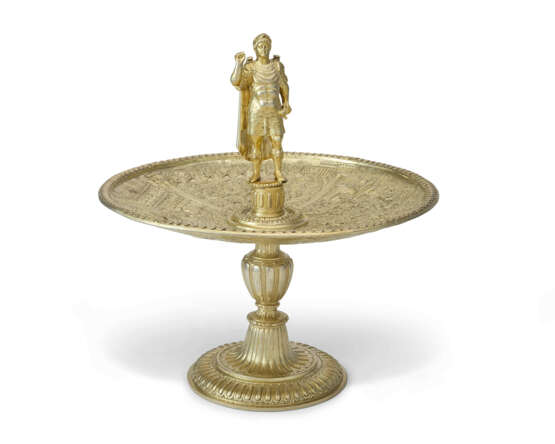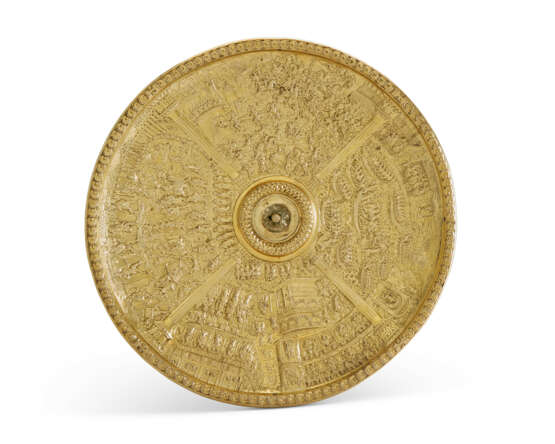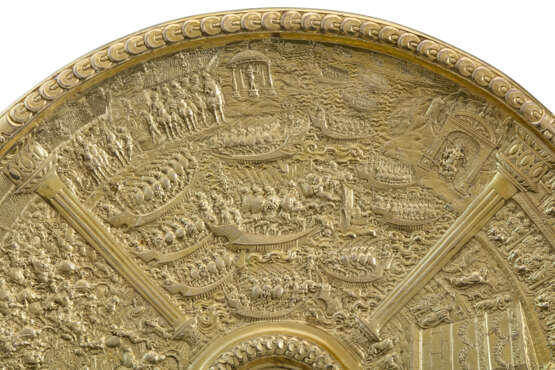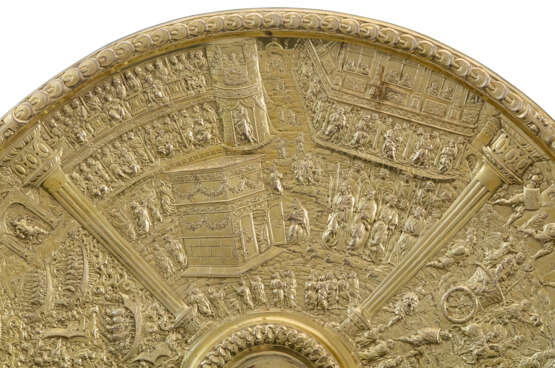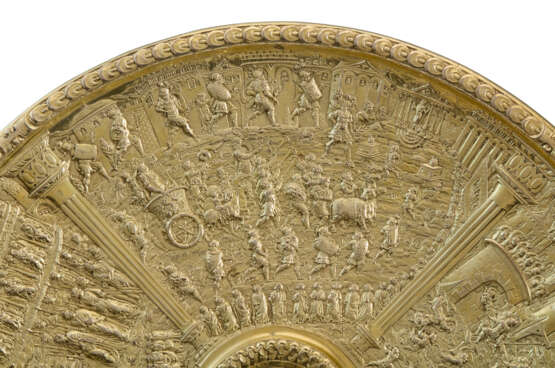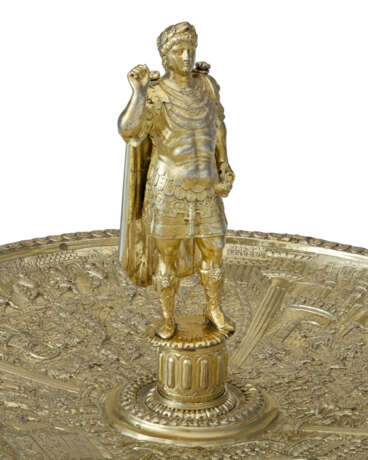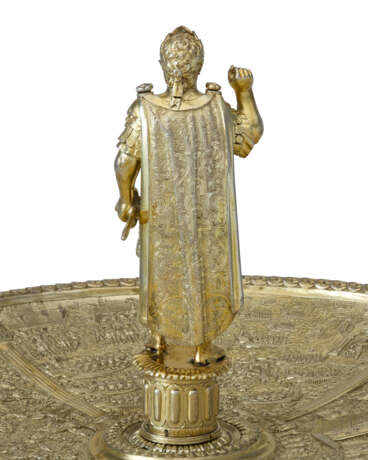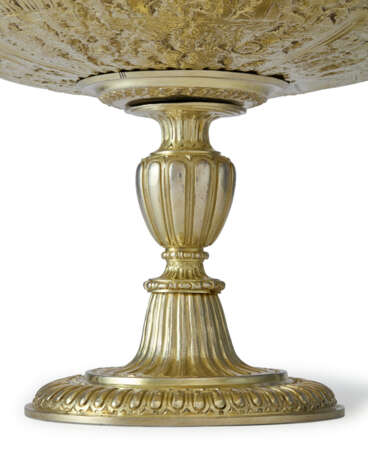ID 1360097
Lot 14 | THE NERO AND AUGUSTUS ALDOBRANDINI TAZZA
Estimate value
$ 2 000 000 – 3 000 000
PROBABLY NETHERLANDISH, 1587-1599
The shallow circular dish supported on an ogee foot and detachable vase shaped stem chased with flutes, the dish embossed and densely chased with four elaborate scenes depicting the life and triumphs of Emperor Augustus, divided by tapering fluted columns, centered by the detachable figure of the Emperor Nero with laurel crown and raised fist standing atop a lobed column engraved NERO, Nero's cape detachable, struck throughout with later French import marks
15 ¾ in. (40 cm.) high; 14 ¾ in. (37.3 cm.) diameter
91 oz. 8 dwt. (2,843 gr.)
Provenance
The Complete Set of Twelve Tazze:
Possibly seen in Ferrara before 16 March 1599 by an acquaintance of the Duke of Mantua, ownership unknown.
Possibly one of six tazze in the possession of dealer David de' Cervi, Milan, March-April 1599.
Possibly one of six tazze purchased by agents of Cardinal Pietro Aldobrandini (1571-1621) in Milan for 791.21 scudi.
Recorded in the 1603 inventory of Cardinal Pietro Aldobrandini, then to his sister,
Olimpia Aldobrandini the Elder (1567-1637), then to her son,
Ippolito Aldobrandini the Younger (1592-1638), created Cardinal at St. Eustachio Basilica, Rome in 1621, recorded in an inventory after his death in 1638, then to his niece,
Olimpia Aldobrandini-Borghese Pamphilj (1623-1682), Princess of Rossano, then to her son,
Giovanni Battista Pamphilj (1648-1709), Duke of Carpineto, recorded in a 1710 inventory.
By decent through the Doria Pamphilj family.
By decent to the Borghese branch of the family by 1769.
Sold and probably dispatched from Rome before 1792.
With the retail silversmith Kensington Lewis (1790-1854), London, circa 1826.
With the retail goldsmith Thomas Hamlet (1770-1853), London, sold by,
George Robins, London, 3 February 1834, lot 22 (as by Benvenuto Cellini).
Purchased at the above sale by the Emanuel Brothers, London.
Charles Scarisbrick, Scarisbrick Hall, Lancashire (1801-1860); Christie's, London, 15 May 1861, lot 159 (as by Benvenuto Cellini).
Purchased at the above sale by Richard Attenborough, The Strand, London, and thereafter the set dispersed.
The Present Nero Figure:
With Gebrüder Bourgeois, Cologne, by 1876.
The collection of Johannes Paul, Hamburg (with the Titus dish and fluted foot); J.M. Heberle (H. Lempertz Söhne), Cologne, 16 October 1882, lot 720 (as by Benvenuto Cellini).
Purchased at the above sale by Heinrich Wencke, Hamburg.
J.M. Heberle )H. Lempertz Söhne), Cologne, 27-28 October 1898, lot 152 (as by Benvenuto Cellini).
The Present Augustus Dish:
The Collection of Frédéric Spitzer (1815-1890), Paris, by 1888, with the Vespasian figure and later foot, later recorded in an inventory of 1891, no. 62, as "Augsburg? 16th century," sold,
Paul Chevallier (commissaire-priseur), Hôtel Drouot, Paris, 17 April - 16 June 1893, lot 1760 (as Vitellius with that figure and later foot).
Purchased at the above sale by Goldschmidt, Frankfurt.
The Figure and Dish as Presented Here:
Acquired by Sir Julius Wernher, 1st Baronet (1850-1912), Bath House, London, bequeathed to his wife,
Alice, Lady Wernher, later Lady Ludlow (1862-1945), then to their son,
Sir Harold Wernher, 3rd Bt G.C.V.O (1893-1973), Bath House, London, later Luton Hoo, Bedfordshire, then by decent, the Nero figure and Augustus bowl displayed together by 1975 with later foot, until sold,
Works of Art from the Wernher Collection; Christie's, London, 5 July 2000, lot 18 (reassembled with an original foot previously part of the Titus figure tazza with electrotype bowl also from the Wernher Collection).
Literature
The Present Tazza:
A. Darcel, La Collection Spitzer: Antiquité-moyen-âge-Renaissance, Paris, 1890-1892, III, Orfevrerie Civile, pls. XIII and XIV, pp. 23-24 (dated 16th Century, Augsburg; pl. XIII illustrates the Vespasian figure on the Augustus dish).
1913 Bath House Inventory, p. 136, no. 677 (the Nero figure).
1914 Bath House Inventory, p. 92, no. 457 (the Nero figure).
M. Urwick-Smith, Luton Hoo: The Wernher Collection, London, 1975, p. 18.
C. Hernmarck, The Art of the European Silversmith 1430-1830, London, 1977, I, pp. 126-127, II, fig. 235 (the Augustus dish, as Italian or French, chased by a German goldsmith).
Exhibition catalogue, The Treasure Houses of Britain: Five Hundred Years of Private Patronage and Art Collecting, Washington D.C., 1985, pp. 578-579, no. 515 (the present Nero figure and Augustus dish, on the Spanish foot)
T. Schroder, Renaissance and Baroque Silver, Mounted Porcelain and Ruby Glass from the Zilkha Collection, London, 2012, cat. no. 6, pp. 73-85.
The Aldobrandini Tazze:
Inventory of the property of Cardinal Ippolito Aldobrandini, 1638, recorded as,
Dodici tazzoni Grandi il piede alto lavorati con diverse historie di basso relievo con Imperatori in piede sopra ciascuno, segnati ciascun pezzo col n.o 52 pesano tutti insieme libre centonove, incie undici e mezza lib. 109: on. 11 ½
(Twelve large tazze on a high foot, worked with historical scenes in low relief, with Emperors standing on top of each one, each piece signed with the number 52; altogether they weigh 109 pounds, 11 ½ ounces)
Archivo di Stato, Rome, Not. Ac. 2661, an inventory drawn up on 2 March 1710 after the death of Prince Giovanni Battista Pamphili, recorded as,
Nella Guardaroba Aldobrandini posta nel Palazzo al Corso habitato dall Em. tima Cardinale D. Benedetto Pamphily. Dodici tazzoni grandi d'argento con piedi alti historiato di baso rilievo con un Imperatore in piedi sopra ciascheduno. Pesano tutti insieme libre cento nove et oncie otto.
(In the Aldobrandini Treasury in the Palazzo al Corso then lived in by Cardinal Benedetto Pamphilj. Twelve large dishes with tall bases, with historical scenes in low relief and a large standing figure of an emperor on each. They weigh 109 pounds and 8 ounces)
R. Ackermann, The Repository of Arts, Literature, Fashions, Manufactures, &c, London, 1826, pp. 303-304 (as by Benvenuto Cellini).
The Times, London, 25 January 1834, p. 8, advertisement (as by Benvenuto Cellini).
The Gentleman's Magazine, London, April 1834, p. 418 (as by Benvenuto Cellini).
J. F. Hayward, Virtuoso Goldsmiths and the Triumph of Mannerism 1540-1620, London, 1976, pp. 164-165 and 371-376, figs. 363-365.
J. Culme, Nineteenth Century Silver, London, 1977, p. 74.
J. Siemon, ed., The Silver Caesars: A Renaissance Mystery, New York, 2017.
Exhibited
Washington D.C., National Gallery of Art, The Treasure Houses of Britain: Five Hundred Years of Private Patronage and Art Collecting, 3 November 1985 - 16 March 1986 (exhibited on the later foot now associated with the Titus figure and copy of the Titus dish also sold from the Wernher Collection).
New York, Metropolitan Museum of Art, The Silver Caesars: A Renaissance Mystery, 12 December 2017 - 11 March 2018.
Buckinghamshire, Waddesdon Manor, The Silver Caesars: A Renaissance Mystery, 18 April - 22 July 2018.
| Applied technique: | Metalwork |
|---|---|
| Medium: | Silver |
| Place of origin: | Belgium, Western Europe, Europe, The Netherlands |
| Category: | Bowls, Tazzas |
| Auction house category: | All other types of objects |
| Applied technique: | Metalwork |
|---|---|
| Medium: | Silver |
| Place of origin: | Belgium, Western Europe, Europe, The Netherlands |
| Category: | Bowls, Tazzas |
| Auction house category: | All other types of objects |
| Address of auction |
CHRISTIE'S 20 Rockefeller Plaza 10020 New York USA | ||||||||||||||
|---|---|---|---|---|---|---|---|---|---|---|---|---|---|---|---|
| Preview |
| ||||||||||||||
| Phone | +1 212 636 2000 | ||||||||||||||
| Fax | +1 212 636 4930 | ||||||||||||||
| Conditions of purchase | Conditions of purchase | ||||||||||||||
| Shipping |
Postal service Courier service pickup by yourself | ||||||||||||||
| Payment methods |
Wire Transfer | ||||||||||||||
| Business hours | Business hours
|
